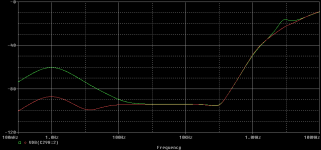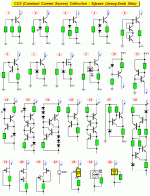For something less complex how about using 2 jfets of matched Idss stacked one on top of the other? This would improve the working voltage to twice that of a single jfet and I think would improve the 56.7 db of one jfet to double or 114 db. Or possibly string 3 of them together? I could be daft.
cascoding matching fets is wrong (if you run them at Idss):
http://www.diyaudio.com/forums/showthread.php?postid=333442#post333442
http://www.diyaudio.com/forums/showthread.php?postid=333442#post333442
It would increase output impedance by a factor of two, but that means 56.7dB+6dB=62.7dB, not 56.7dB+56.7dB. Logarithmic addition is linear multiplication.
real world tolerance would prevent series ccs crd connection from helping, the crd with infinitesimally (uA) higher limit current would saturate and look like a sorta nonlinear resistor of low value compared to the working crd MegaOhm Z
Good point. The second JFET (the one with a higher Vto) would be better used as a cascode across the CCS JFET anyway. It would provide a lot more than 6dB improvement in output impedance.
MikeB said:I am looking for an "ideal" ccs, i attached a small collection of 9 different ccs circuits, all rated with a psrr. This db value is the voltage ripple visible at the 1k resistor with the power supply contaminated with 1v AC, all ccs giving ~3ma. The LED style is missing because i have no model...
Did i forget other / better circuits ? Right now the cascoded jfet-ccs seems to be the candidate. Number 9 is also very interesting as it is floating style like a single jfet-ccs.
What i want is a ccs with high psrr, but not too complicated.
Mike
Mike
What is it's application? Many different CCS designs with various
strengths and weaknesses.
Application will be best decider of what type to use.
Cheers
Terry
Ah yes, the ccs will be used to feed an input-LTP. In detail, i am trying to build a symasym with optimzed psrr to check the sonic advantages.
Attached is negative psrr of a symasym6, green uses standard 2-bjt-ccs, red cascoded jfet. As you can see, psrr degrades heavily below 100hz, also the normal ccs shows a resonance at 9mhz.
The peak at 13hz down shows that there is an additional problem...
As i want to publish schematic, i should avoid use of exotic parts, they would be substituted anyway.
Mike
Attached is negative psrr of a symasym6, green uses standard 2-bjt-ccs, red cascoded jfet. As you can see, psrr degrades heavily below 100hz, also the normal ccs shows a resonance at 9mhz.
The peak at 13hz down shows that there is an additional problem...
As i want to publish schematic, i should avoid use of exotic parts, they would be substituted anyway.
Mike
Attachments
kubeek said:MikeB, what simulation software did you use for the initial measurements?
I used some PSpice version...
 I really need to switch to LTspice.
I really need to switch to LTspice.  Orcad might be
Orcad might be  At least i don't make any profit.
At least i don't make any profit.Mike
dshortt9 said:Not what I meant. Imagine stacking 2 CR300 diodes. A good thing or not?
Probably not. Best thing that could happen would be twice the
impedance. There are ways to get more for doubling the
investment.
More probable is, that the diode with the slightly smaller current value
determines the current that flows and the second does nothing but
stealing voltage headroom from the first.
The result would be worse performance than using the first diode
alone. This is especially true if you have only a low voltage to
spend; the situation where a good current source would be needed most.
Gerhard
MikeB said:I made more sims, also adding the "self cascoding" jfet ccs. (see attachment)
The self cascoding shows an impressive -114db...
Than i ran a transient analysis to check stability of these circuits.
I quickly rejected the "self cascoding", it has ringing like hell, asking for problems. Also i rejected all circuits showing any ringing or beeing ugly slow, this left over 3 circuits, the zener referenced ones and the cascoded jfet.
Number 7 (the cascoded jfet) seems to be best option regarding psrr AND stability. (the most stable one)
2nd choice would be Number 3, simple but efficient and stable. Better than my favourite (until today), the No1....
Mike
If You add some filter capacitors paralell with the zener (with the zener referenced version), You can increase the PSRR. Or is it bad idea?
sajti
Principally a good idea, but my supply rails to the frontend are already filtered. As i want increased psrr at very low freq i have to use ccs circuit without filtering. (or giant caps)
Mike
Mike
Mike,
You indicated that many (most) of the current sources you sim'ed had stability issues or were very sluggish. This seems rather important as most of our amplifier testing would not reveal this. Power supply "artifacts" can be rather nasty and would tend to excite any instabilities. Have you tried listening to your symasym using one of the solid ccs's ?
Bill
You indicated that many (most) of the current sources you sim'ed had stability issues or were very sluggish. This seems rather important as most of our amplifier testing would not reveal this. Power supply "artifacts" can be rather nasty and would tend to excite any instabilities. Have you tried listening to your symasym using one of the solid ccs's ?
Bill
Sajti, when putting the cap parelell to zener diode you gain not much, psrr already degrades below 100hz. Using bootstrap cap to the feeding resistor (split into 2x10k) lowers that to 0.1hz with the same cap, which is already not bad. But for this "experiment" i'd like to get psrr flat down to dc. Also caps like these ask for turn on thumps.
MaxS, thank for this huge collection, stored to disk...
Hi Bill, haven't tried yet, but right now symasym uses the 2bjt ccs, this also shows minor stability problems.
Mike
MaxS, thank for this huge collection, stored to disk...
Hi Bill, haven't tried yet, but right now symasym uses the 2bjt ccs, this also shows minor stability problems.
Mike
sajti said:If You replace the 22kohm resistor with another simple ccs?
sajti
That's No8 in my collection... 😉 It gives a +12db and is one of the candidates. But No7 (cascoded jfet) is even faster and has higher psrr.
I still need to research jcx's suggestion with the bootstrapped version.
Mike
- Status
- Not open for further replies.
- Home
- Amplifiers
- Solid State
- Searching the "best" CCS

